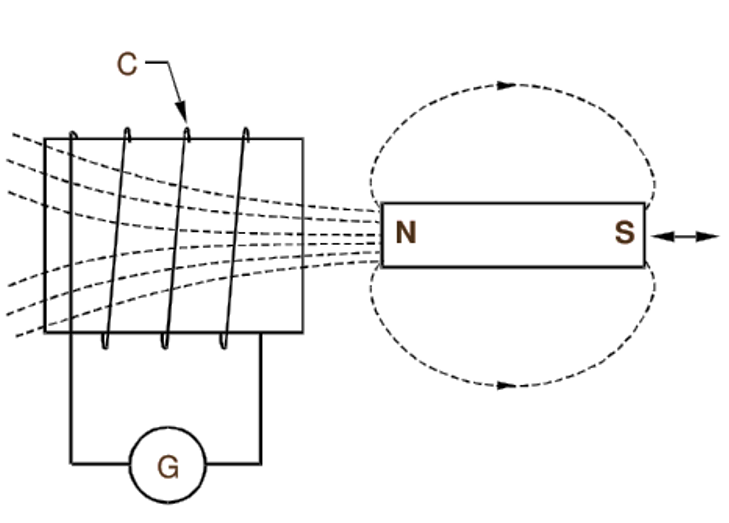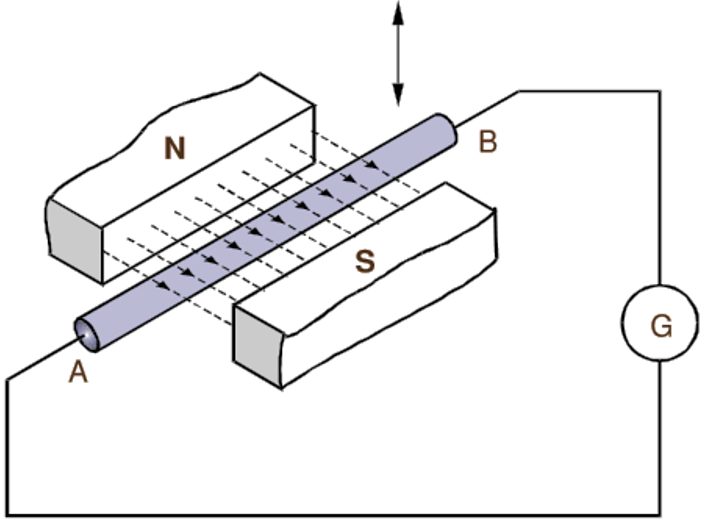In this topic, you study Electromagnetic Induction.
After the discovery regarding the association of magnetic field with the current carrying conductor by Oersted in 1820, attempts were made in the direction of producing the electric current with the aid of the magnetic flux. Ultimately in 1831, Michael Faraday, an English physicist succeeded in it. The phenomenon discovered by him due to which an electromotive force and hence the current is induced in any conductor which cuts or is cut by a magnetic flux is known as electromagnetic induction.
FARADAY’S LAW OF ELECTROMAGNETIC INDUCTION
- To facilitate the understanding of the basic law formulated by Faraday giving the relationship between the induced e.m.f. and the inducing field, let us consider the following experiments.
- Fig. 1 (a) shows a coil (C) connected to a galvanometer (G).
- When a permanent magnet (N-S) is moved relative to coil in such a way that the number of lines of force passing through the coil is altered, it is observed that the galvanometer deflects in one direction when the magnet is moved towards the coil and in the reverse direction when the magnet is withdrawn.
- The deflection in either direction lasts so long as the magnet s in motion relative to the coil. Obviously, the deflection of the galvanometer indicates the production of the e.m.f.
- It is also seen that the more quickly the magnet is moved, the greater is the deflection and therefore, the e.m.f. Similar results are obtained if the magnet is fixed and the coil is moved relative to the magnet.
- Fig. 1 (b) illustrates another situation in which a conductor (AB) is connected to a galvanometer (G) and placed in a magnetic field.
- It is then observed that whenever this conductor is moved up or down so as to cut lines of force, the galvanometer shows a deflection, thereby indicating the existence of the e.m.f.

(a)

(b)
Fig.1: Electromagnetic induction
- As in the previous case, the deflection of the galvanometer is in one direction when the conductor is moved up and in the reverse direction when it is moved downwards. Also, the deflection and therefore, the magnitude of the induced e.m.f. depends on the quickness of the movement of the conductor.
- Summing the results of the above experiments, we get the famous law known as Faraday’s law of electromagnetic induction.
The Faraday's law of electromagnetic induction states that whenever the number of lines of force linking with a circuit changes, an e.m.f. is always induced in it. The magnitude of this induced e.m.f. is proportional to the rate of change of flux linkages (flux x turns). Such an e.m.f. lasts as long as the change is taking place.
Alternatively, the law can also be stated as follows:
When a conductor cuts or is cut by the magnetic flux, an e.m.f. is generated in the conductor and the magnitude of the generated e.m.f. is proportional to the rate at which the conductor cuts or is cut by the magnetic flux.
- For more clearity, it is also a practice to state the above law in the form of two separate laws as follows :
Faraday’s First Law
This law states that whenever the number of lines of force linking with a circuit changes, an e.m.f. is always induced in it; or whenever a conductor cuts or is cut by the magnetic flux, an e.m.f. is always generated in it.
Faraday’s Second Law
It states that the magnitude of the induced e.m.f. in any circuit is proportional to the rate of change of its flux linkages (flux x turns); or the magnitude of the generated e.m.f. in any conductor is proportional to the rate at which it cuts or is cut by the magnetic flux.
- In short, the first law explains the circumstances under which an e.m.f. is induced in a circuit or conductor and second law gives the information regarding the magnitude of this e.m.f.